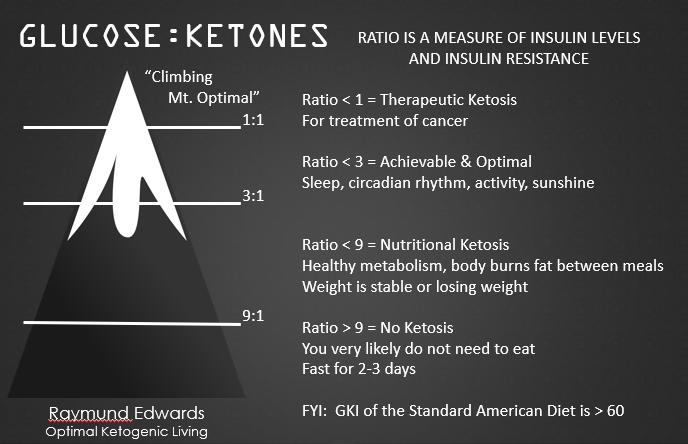
Whether scouring the keto subreddits, watching your favorite YouTube keto pros, or reading the countless keto forums, you’ve likely come across the term GKI, which stands for the Glucose Ketone Index. This may have left you wondering, “What exactly is the GKI?”
I’ll take a moment to tell you what the GKI is and why it’s an important tool if you’re considering a keto diet or actively living the keto lifestyle.
Understanding What GKI Is All About
The GKI was developed by Dr. Thomas Seyfried while working with brain tumor patients utilizing the metabolic theory of cancer. It was created to track and manage a patient’s metabolic state for better brain tumor management. Essentially, his work involved using the GKI to optimize the state of metabolism that would be most effective in halting brain tumor growth.
In the simplest terms, the GKI is a simple equation that helps track the ratio of blood glucose to ketones as a single value. In this format, it becomes an easy biomarker for tracking the level of ketosis that someone is in, along with keeping tabs on their overall metabolic health.
As we all have bio-individuality, what works for one will not necessarily work for another. The GKI provides a stabilized metric to help each individual determine what works for their body.
Necessary Tools
Like all things nutritional health, you must have the necessary tools to accomplish your goals, so to determine and track your GKI, you’ll need access to a blood glucose and ketone testing meter.
Testing meters typically use a lancing device to prick your finger, and a test strip is entered into the meter and the meter itself.
This handy and easy-to-use instrument gives you a readout of where your blood glucose and ketones are at a given moment. Because these readings are variable and can fluctuate depending on several other factors, the GKI can provide a normalized view of metabolism that considers these variables. What you’re left with is a more accurate and stable picture of your metabolic status and your state of ketosis.
Your blood glucose and ketone tests should be conducted 2 to 3 hours after eating a meal, and you should run this test twice daily. Getting a measurement twice daily can give you the data you need to recognize how your diet affects your GKI and give you the power to make the adjustments you need.
Shop Blood Ketone Meters on Amazon!



Glucose Ketone Index Calculation
No need to stress about the numbers because you’ll find that there are online calculators that will run the computation for you. But, for those who like to go into things with full knowledge, here’s the simple equation used to determine your GKI.
[Glucose Reading (mg/dL) ÷ 18] ÷ Ketone Reading (mmol/L) = Glucose Ketone Index
An online calculator or app requires you to plug in your readings, and then it does the work for you, producing your GKI. All you need to do is match your GKI number to your target and see how well you’re doing. (1)
Tracking Your State of Ketosis

Once you know your GKI, you can track your status and get a better view of how you’re doing with your keto diet. No matter what your reasons are for adopting and maintaining a keto diet and lifestyle, you can use the GKI to make certain that you’re hitting your goals.
Let’s take a moment to consider the different goals and motivations why someone may begin following a ketogenic diet. Many people follow a keto diet as a therapeutic complement in the management of chronic health conditions, including everything from brain cancer (2) and type 2 diabetes to epilepsy, chronic inflammatory conditions, neurodegenerative diseases, and more. (3)
Others may be more interested in losing weight or maintaining a healthy weight. Different goals will require different states of ketosis, and the GKI number can help you ensure you’re meeting your targets.
Lowering Your Glucose Ketone Index
So, you’ve got the tools and understand your motivations, goals, and targets, but you’re feeling discouraged because you’re not where you want (or need) to be. Don’t look at this as a problem but as an opportunity! Ok, maybe that’s easier said than done, but it’s always important to remind yourself that you can make simple changes, and these slight alterations can lead you further along the path to real results.
If your GKI reading is too high, look at your diet again. Could your less-than-optimal readouts affect how long you’ve been following the keto diet? If yes, then stick to it! The longer you follow a ketogenic lifestyle and eat a whole-food diet, the better your GKI readings will be.
Maybe you still see some pitfalls in your diet. Then, this is a great moment to take a little time to identify and eliminate your trigger foods. Use your GKI tracking to see which meals are working for you and which aren’t. Try out new recipes and see if a meal works better for your body than something you’re currently eating. You may surprise yourself and find a new favorite to help you reach your goals.
And, if you’ve made the necessary dietary changes or are feeling a little stumped on the food side of things, take the time to focus on some other factors that may be playing a role, like stress management and ensuring that you’re getting adequate and restful sleep.
As with everything in life, knowledge is power. When you know better, you can do better, and that’s just what the GKI can help you do with your keto diet -- give you the knowledge of what’s working and what’s not and bring you closer to reaching your goals!
You may also be interested in the following articles:
- Cheating on Keto: 6 Tips for Recovery
- Ketosis Signs and Symptoms - What to Expect
- 5 Nutritional Foundations for Optimal Health
Sources
- KetoMojo. Glucose Ketone Index [GKI] [Internet]. [cited 22nd June 2020]. Available from: https://keto-mojo.com/glucose-ketone-index-gki/.
- Meidenbauer JJ, Mukherjee P, Seyfried TN. The glucose ketone index calculator: a simple tool to monitor therapeutic efficacy for metabolic management of brain cancer. Nutr Metab (Lond). 2015; 12: 12.
- Paoli A, Rubini A, Volek JS, Grimaldi K.A. Beyond weight loss: A review of the therapeutic uses of very-low-carbohydrate (ketogenic) diets. Eur J Clin Nutr. 2013; 67(8): 789-796.



















Comments
No Comments